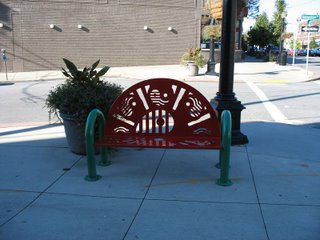Public Squares: Some Thoughts
A recent discussion of a proposed park in downtown Minneapolis got me thinking about the origins of public spaces. I was going to add a rather lengthy comment to the discussion on Zack's site, but rather than clutter up his server I'm posting my thoughts as a stand-alone entry here.
The question, aptly put by one of the posters, is this: Why are there so few public squares / spaces in modern American cities? To answer this, let's look at the origins of the city square. To my knowledge, there are three primary lines of evolution:
(1) Shared pasture land in agricultural places. In this case, the town "commons" was an area in the center of town where you could stick your livestock. The sheep/cows/etc. could munch on grass all day, and you could safely secure *everyone's* animals in a central place. You see this a lot in New England, although those spaces are no longer used for this purpose (!).
(2) The Roman forum. Romans considered public speaking and debate a central aspect of a city's democracy. To that end, the ensured that forums--open spaces where people could address crowds--were central in the design of their cities.
(3) Open marketplaces: Malls, or rather assemblages of stores, used to be open-air affairs. Though, notably, there are some interesting renaissance-era gigantic indoor marketplaces. Anyway, there are some public spaces today that grew out of such a use.
So the problem for modern American cities is that neither the sharing of livestock nor the sharing of public opinion is considered a top priority. The third one--the marketplace--shows some potential. The latest trend in mall development is away from enclosed structures and towards open-air malls (a.k.a "lifestyle centers"). Aside from the obvious marketing misdirection inherent in the renaming, this shift in development tactics may encourage the growth of public spaces. Outdoor malls, unlike indoor ones, better promote visibility and heterogeneity of uses, two essential aspects of a public space (see earlier posts).
So I guess there's hope, eh? Keep your fingers crossed; I don't think Americans are about to buy a bunch of cows and form grazing co-ops.
The question, aptly put by one of the posters, is this: Why are there so few public squares / spaces in modern American cities? To answer this, let's look at the origins of the city square. To my knowledge, there are three primary lines of evolution:
(1) Shared pasture land in agricultural places. In this case, the town "commons" was an area in the center of town where you could stick your livestock. The sheep/cows/etc. could munch on grass all day, and you could safely secure *everyone's* animals in a central place. You see this a lot in New England, although those spaces are no longer used for this purpose (!).
(2) The Roman forum. Romans considered public speaking and debate a central aspect of a city's democracy. To that end, the ensured that forums--open spaces where people could address crowds--were central in the design of their cities.
(3) Open marketplaces: Malls, or rather assemblages of stores, used to be open-air affairs. Though, notably, there are some interesting renaissance-era gigantic indoor marketplaces. Anyway, there are some public spaces today that grew out of such a use.
So the problem for modern American cities is that neither the sharing of livestock nor the sharing of public opinion is considered a top priority. The third one--the marketplace--shows some potential. The latest trend in mall development is away from enclosed structures and towards open-air malls (a.k.a "lifestyle centers"). Aside from the obvious marketing misdirection inherent in the renaming, this shift in development tactics may encourage the growth of public spaces. Outdoor malls, unlike indoor ones, better promote visibility and heterogeneity of uses, two essential aspects of a public space (see earlier posts).
So I guess there's hope, eh? Keep your fingers crossed; I don't think Americans are about to buy a bunch of cows and form grazing co-ops.










